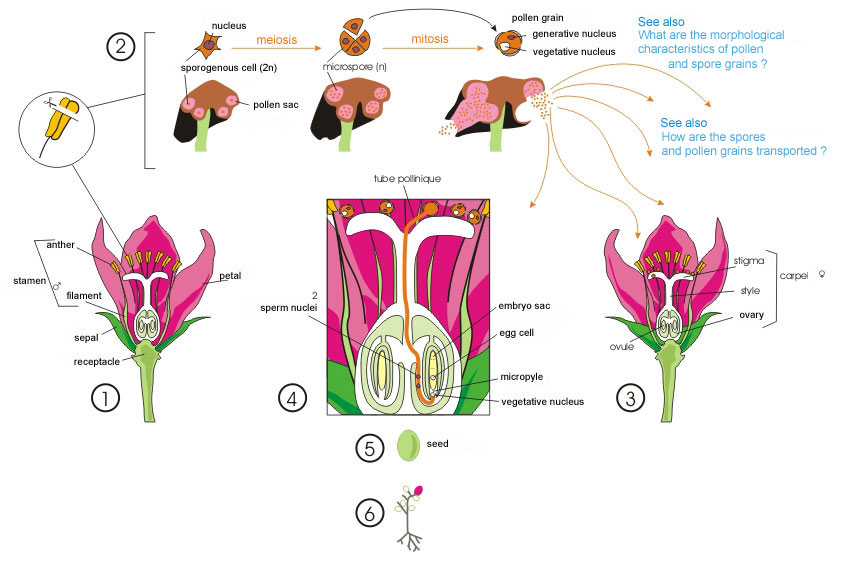What is pollen in the reproduction cycle of flowering plants?
A pollen grain is a microspore containing the male gametophyte, usually reduced to two undivided cells, each with one haploid (n) nucleus. These cells are surrounded by a very resistant wall, the exine, which generally has apertures, zones with less resistance which will allow the germination of the pollen tube.
Explanation of the reproduction cycle
(cf diagram above)
- A given species produces flowers bearing stamens. According to species, these flowers can be unisexual (stamens only) or bisexual (stamens and carpels).
- The stamen anthers include 4 pollen sacs containing sporogenous cells (diploid=2n). These sporogenous cells undergo meiosis, each producing 4 microspores (haploid=n). Two nuclei are then formed by mitosis : the vegetative nucleus and the generative nucleus. The latter divides to form 2 sperms. Simultaneously the wall of the microspores becomes thicker and takes the characteristic shape of the species : it is a pollen grain (see: What are the morphological characteristics of pollen and spore grains?). In the majority of species, the 4 grains (resulting from the 4 microspores) split up into single grains; in some cases, they remain together (tetrad = group of 4 grains). When mature, pollen grains are released by the opening of the anthers.
- A pollen grain is aimed at reaching another flower of the same species, bearing carpels. The ovaries contain ovules, in which meiosis occurs, then mitoses. It results in an embryo sac with 8 nuclei, among which an egg cell and 2 central cells. When a pollen grain arrives on another flower (see : How are the spores and pollen grains transported?), it is received by the stigmas.
- The pollen grain germinates through an opening of the wall: the vegetative nucleus develops into a pollen tube which is guided by the style to the ovary, then enters the micropyle of an ovule. The pollen tube releases 2 sperm nuclei into the ovule: one of the sperms fuses with the egg cell into a zygote (2n), while the other sperm fuses with central nuclei and gives rise to albumen (= food source). There are generally several ovules in an ovary : each one can be fertilized by a distinct pollen grain.
-
Each fertilized ovule and its albumen form a seed that will develop into a new individual of this species.

